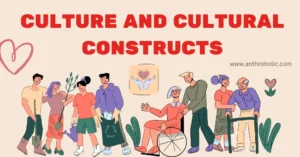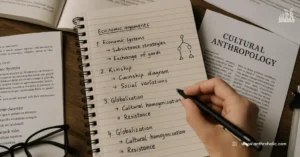AI Answer Evaluation Platform Live Now. Try Free Answer Evaluation Now
Civilization
Civilization, a term often invoked in discussions about society and culture, carries a wealth of implications about the history and organization of human societies.

Origins of the Concept of Civilization
The term “civilization” is derived from the Latin word civis, meaning citizen, and later, civilis, relating to citizens. It eventually evolved to encompass a broad set of cultural characteristics that distinguish advanced societies (Fernandez-Armesto, 2011).
The concept of civilization gained prominence during the Age of Enlightenment in the 18th century. Philosophers like Montesquieu and Voltaire used the term to classify societies based on their level of development and cultural sophistication. They believed European societies represented the pinnacle of civilization, while others were positioned hierarchically below them. This Eurocentric viewpoint, however, has been contested in contemporary discourse (Eisenstadt, 2003).
Defining Characteristics of Civilizations
Although civilizations exhibit considerable variety, scholars have identified a few common characteristics that most civilizations tend to share.
1. Advanced Cities: The emergence of advanced cities marks a significant shift from nomadic lifestyles to settled communities, fostering economic growth and cultural exchanges (Childe, 1950).
2. Specialized Workers: With the growth of cities comes the need for specialized labor. In a civilization, people take up diverse occupations like farming, craft production, trade, priesthood, and administration (Wright, 2006).
3. Complex Institutions: Civilizations develop complex institutions such as governmental systems, religions, educational systems, and economic structures to maintain social order and promote cultural coherence (McNeill & McNeill, 2003).
4. Record Keeping: Writing and record-keeping are vital in managing the complexities of civilization. They enable the transmission of knowledge, preservation of history, and enforcement of laws (Goody, 1987).
5. Advanced Technology: Civilizations often showcase technological advancements. These could range from advancements in agriculture, such as irrigation systems, to achievements in architecture, transportation, and warfare (Diamond, 1997).
Varied Forms and Evolution of Civilizations
Civilizations have manifested themselves in a plethora of forms throughout human history. They have also demonstrated a capacity to evolve and adapt over time.
1. River Valley Civilizations: Early civilizations often arose in river valleys, such as the Mesopotamian, Egyptian, Indus Valley, and Yellow River civilizations. These environments provided fertile lands for agriculture and a steady water supply (Fagan, 2004).
2. Classical Civilizations: Classical civilizations like Greece and Rome expanded upon the foundations laid by earlier civilizations, developing sophisticated political systems, philosophies, and artistic traditions (Bowman & Chambliss, 2010).
3. Non-Western Civilizations: Civilizations also flourished outside the West. The Maya, Aztec, and Inca in the Americas; the Persian, Mauryan, and Gupta empires in Asia; and the Mali and Songhai empires in Africa, are notable examples (Andrea & Overfield, 2005).
4. Modern Civilizations: In the modern era, industrialization, scientific progress, and democratization have dramatically reshaped civilizations, leading to unprecedented levels of wealth, knowledge, and personal freedom (Huntington, 1996).
The Impact and Influence of Civilizations
Civilizations have profound impacts both internally and externally. They foster cultural identity, facilitate societal development, and often influence surrounding societies through processes such as trade, conquest, and cultural diffusion (Spengler, 1918).
1. Internal Impact: Internally, civilizations provide a collective identity to their inhabitants through shared language, religion, and customs. They also enable societal development by establishing structures for governance, economic activity, and knowledge dissemination (Tylor, 1871).
2. External Influence: Externally, civilizations have significant influence on neighboring societies. This may occur through peaceful means, such as trade and cultural exchange, or through forceful methods, like conquest and colonization (Toynbee, 1946).
Conclusion
Civilization is a complex and multifaceted concept, rooted in human sociocultural evolution. It represents the culmination of human ingenuity and organization, manifested in advanced cities, specialized workers, complex institutions, record-keeping, and technology. Civilizations have significantly shaped the course of human history and continue to leave indelible marks on the world we live in today.
References
- Andrea, A. J., & Overfield, J. H. (2005). The Human Record: Sources of Global History. Houghton Mifflin.
- Bowman, L., & Chambliss, W. J. (2010). Exploring Society: Pathways to Sociology. Routledge.
- Childe, V. G. (1950). The Urban Revolution. Town Planning Review.
- Diamond, J. (1997). Guns, Germs, and Steel: The Fates of Human Societies. W.W. Norton & Co.
- Eisenstadt, S. N. (2003). Comparative Civilizations and Multiple Modernities. Brill.
- Fagan, B. M. (2004). People of the Earth: An Introduction to World Prehistory. Pearson Prentice Hall.
- Fernandez-Armesto, F. (2011). Civilizations. Free Press.
- Goody, J. (1987). The Interface between the Written and the Oral. Cambridge University Press.
- Huntington, S. P. (1996). The Clash of Civilizations and the Remaking of World Order. Simon & Schuster.
- McNeill, W. H., & McNeill, J. R. (2003). The Human Web: A Bird’s-Eye View of World History. W. W. Norton & Company.
- Spengler, O. (1918). The Decline of the West. Oxford University Press.
- Toynbee, A. (1946). A Study of History. Oxford University Press.
- Tylor, E. B. (1871). Primitive Culture. John Murray.
- Wright, R. (2006). A Short History of Progress. House of Anansi.



